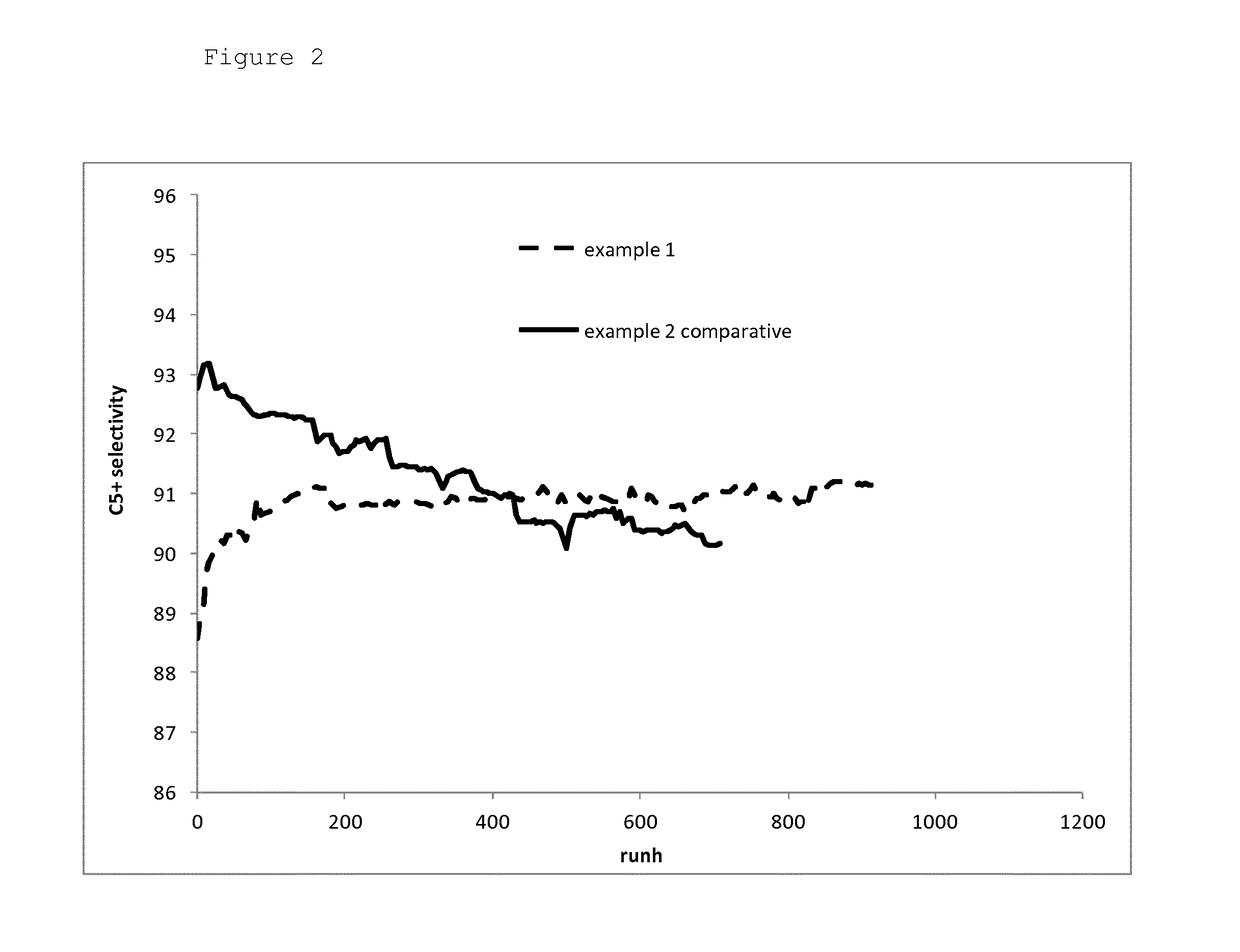A method for start-up and operation of a fischer-tropsch reactor
a technology of fischer-tropsch reactor and reactor head, which is applied in the direction of catalyst activation/preparation, physical/chemical process catalysts, metal/metal-oxide/metal-hydroxide catalysts, etc., can solve the problem of high relative humidity at the start of the fischer-tropsch process, the catalyst's activity will decrease over time, and the proof is difficult to regain an activity level. , to achieve the effect of high initial activity
- Summary
- Abstract
- Description
- Claims
- Application Information
AI Technical Summary
Benefits of technology
Problems solved by technology
Method used
Image
Examples
example 1
Invention
[0062]A cobalt-based Fischer-Tropsch catalyst was loaded in a reactor tube and reduced. Then synthesis gas to which ammonia was added such that the synthesis gas comprised 10 ppmv ammonia was supplied to the reduced catalyst. The initial reaction was set such that the resulting space time yield (STY) was 200 grams hydrocarbon products per litre catalyst per hour. The initial reaction temperature thus set was 215° C. The STY was maintained at a value of 200 g / l·h during 900 runhours by gradually decreasing the ammonia concentration until the ammonia concentration in the synthesis gas was 0.7 ppmv. Then the ammonia addition was stopped and the STY was maintained at 200 g / l·h by adjusting the reaction temperature. Immediately upon stopping the ammonia addition, the reaction temperature had to be decreased in order to maintain the STY at a value of 200 g / l·h. Subsequently, the reaction temperature had to be gradually increased to maintain STY at 200 g / l·h. At 300 runhours after...
example 2
Comparative
[0063]The experiment of Example 1 was repeated but now without addition of ammonia to the synthesis gas. As in experiment 1, the reactor productivity (STY) was maintained at a value of 200 g / l·h during the experiment.
[0064]The initial reaction temperature needed to set the reactor productivity (STY) at a value of 200 g / l·h was below 200° C. During the experiment the reaction temperature had to be gradually increased to maintain STY at 200 g / l·h. After 1,200 runhours, the experiment was stopped and the intrinsic activity of the catalyst was determined.
[0065]The intrinsic activity of the catalyst used in experiment 1 was 20% higher than the intrinsic activity of the catalyst used in comparative experiment 2. This shows that the method according to the invention results in improved catalyst stability compared to a process wherein no N-containing compound is used for suppressing the catalyst activity during start-up and the initial operation phase of the reactor.
[0066]FIGS. 1...
example 3
[0070]In order to test the ability of an amine to reversibly inactivate a cobalt-based Fischer-Tropsch catalyst, the following experiment was carried out.
[0071]A reduced cobalt-based Fischer-Tropsch catalyst was loaded in a reactor tube. Synthesis gas to which no N-containing compounds was added (less than 10 ppbv N-containing compounds) was supplied to the catalyst. The reactor productivity was set at a value of 200 g / l·h. Subsequently, trimethylamine was added to the synthesis gas that was supplied to the reduced catalyst in an amount that the trimethylamine concentration in the synthesis gas was 0.5 ppmv. The reaction temperature needed to maintain the reactor productivity had to be increased to 214° C. Subsequently, the addition of trimethylamine was stopped and the reaction temperature had to be decreased to about the initial reaction temperature in order to maintain the reactor productivity at 200 g / l·h. In the Table is shown the relative catalyst activities prior to trimethyl...
PUM
| Property | Measurement | Unit |
|---|---|---|
| temperature | aaaaa | aaaaa |
| reaction temperature | aaaaa | aaaaa |
| reaction temperature | aaaaa | aaaaa |
Abstract
Description
Claims
Application Information
 Login to View More
Login to View More - R&D
- Intellectual Property
- Life Sciences
- Materials
- Tech Scout
- Unparalleled Data Quality
- Higher Quality Content
- 60% Fewer Hallucinations
Browse by: Latest US Patents, China's latest patents, Technical Efficacy Thesaurus, Application Domain, Technology Topic, Popular Technical Reports.
© 2025 PatSnap. All rights reserved.Legal|Privacy policy|Modern Slavery Act Transparency Statement|Sitemap|About US| Contact US: help@patsnap.com


